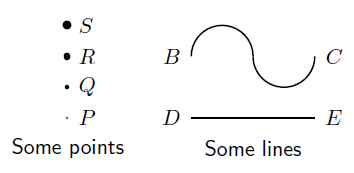| << Chapter < Page | Chapter >> Page > |
The purpose of this chapter is to recap some of the ideas that you learned in geometry and trigonometry in earlier grades. You should feel comfortable with the work covered in this chapter before attempting to move onto the Grade 10 Geometry chapter , the Grade 10 Trigonometry chapter or the Grade 10 Analytical Geometry chapter . This chapter revises:
The two simplest objects in geometry are points and lines .
A point is a coordinate that marks a position in space (on a number line, on a plane or in three dimensions or even more) and is denoted by a dot. Points are usually labelled with a capital letter. Some examples of how points can be represented are shown in [link] .
A line is a continuous set of coordinates in space and can be thought of as being formed when many points are placed next to each other. Lines can be straight or curved, but are always continuous. This means that there are never any breaks in the lines (if there are, they would be distinct lines denoted separately). The endpoints of lines are labeled with capital letters. Examples of two lines are shown in [link] .

Lines are labelled according to the start point and end point. We call the line that starts at a point and ends at a point , . Since the line from point to point is the same as the line from point to point , we have that .
When there is no ambiguity (which is the case throughout this text) the length of the line between points
and
is also denoted
Note: in higher mathematics, where there might be some ambiguity between when we want refer to the length of the line and when we just want to refer to the line itself, the notation
A line is measured in units of length . Some common units of length are listed in [link] .
| Unit of Length | Abbreviation |
| kilometre | km |
| metre | m |
| centimetre | cm |
| millimetre | mm |
An
angle is formed when two straight lines meet at a point. The point at which two lines meet is known as a
vertex . Angles are labelled with a
called a caret on a letter. For example, in
[link] the angle is at
. Angles can also be labelled according to the line segments that make up the angle. For example, in
[link] the angle is made up when line segments
and
meet. So, the angle can be referred to as

Notification Switch
Would you like to follow the 'Siyavula textbooks: grade 10 maths [caps]' conversation and receive update notifications?